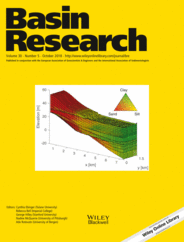
Full text loading...
 , Kamaldeen Olakunle Omosanya1
, Kamaldeen Olakunle Omosanya1 , Ståle Emil Johansen1, Ovie Emmanuel Eruteya2, Yakufu Niyazi3
, Ståle Emil Johansen1, Ovie Emmanuel Eruteya2, Yakufu Niyazi3
Canyons and other sediment conduits are important components of the deep‐water environment and are the main pathways for sediment transport from the shelf to the basin floor. Using 3‐D and 2‐D seismic reflection data, seismic facies and statistical morphometric analyses, this study showed the architectural evolution of five canyons, two slide scars and four gullies on the southern part of the Loppa High, Barents Sea. Morphometric parameters such as thalweg depth (lowest point on a conduit's base), wall depth (middle point), height, width and base width, sinuosity, thalweg gradient, aspect ratio (width/height) and cross‐sectional area of the conduits were measured at intervals of 250‐m perpendicular to the conduits’ pathways. Our results show that the canyons and slide scars in the study area widen down slope, whereas the gullies are narrow and short with uniform widths. The sediment conduits in the study area evolved in three stages. The first stage is correlated with a time when erosion and bypass were dominant in the conduits, and sediment transferred to the basin in the south. The second stage occurred when basin subsidence was prevalent, and a widespread fine‐grained sequence was deposited as a drape blanketing the canyons and other conduits. A final stage occurred when uplift and glacial erosion configured the entire southern Loppa High into an area of denudation. Our work demonstrates that the morphometric parameters of the canyons, slide scars and gullies generally have increasing linear trends with down‐slope distance, irrespective of their geometries. The morphometric analysis of the sediment conduits in the study area has wider applications for understanding depositional processes, reservoir distribution and petroleum prospectivity in frontier basins.

Article metrics loading...

Full text loading...
References


Data & Media loading...
Supplements

